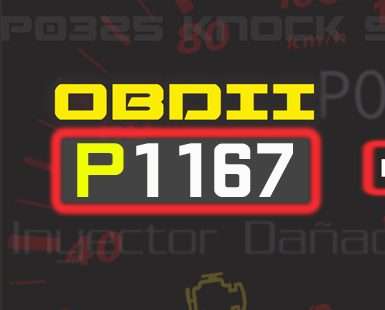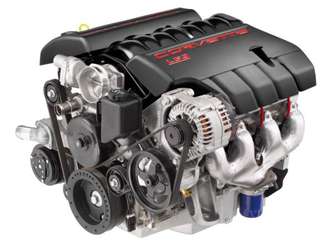
P1167 (Volkswagen, Audi, Skoda, Seat) Mass air flow (MAF) sensor, bank 2 - unreliable signal
Content
P1167 – OBD-II Trouble Code Technical Description
Trouble code P1167 indicates an unreliable signal in the mass air flow (MAF) sensor circuit, bank 2 in Volkswagen, Audi, Skoda, Seat vehicles.
What does the fault code mean P1167?
Trouble code P1167 indicates a problem with the mass air flow (MAF) sensor bank 2 (usually the second bank of cylinders on multi-bank engines) in the engine intake system. The MAF sensor measures the amount of air entering the engine and transmits this information to the engine control unit (ECU). The ECU uses this information to adjust the fuel/air mixture required for proper engine operation. Due to an inaccurate signal from the MAF sensor, the ECU may not properly regulate the fuel/air mixture, which can result in decreased engine performance, increased emissions, and increased fuel consumption.

Possible reasons
Trouble code P1167 can be caused by various reasons:
- Faulty MAF sensor: One of the most common and obvious causes is a malfunction of the mass air flow (MAF) sensor itself. This may be due to wear, contamination, or other damage to the sensor.
- Electrical connection problems: A poor electrical connection, corrosion, or broken wiring associated with the MAF sensor can result in an unreliable signal and a P1167 code.
- Damaged or misaligned sensors: In some cases, sensors can become damaged or misaligned due to vibrations or other factors, which can also lead to unreliable data.
- Problems with the intake system: Problems with the intake system, such as air leaks or a clogged air filter, can affect the MAF sensor and cause P1167.
- Problems with the engine control unit (ECU): Incorrect operation of the engine control unit can also cause erroneous signals from the MAF sensor and the appearance of this error code.
To accurately determine the cause of the P1167 code, it is recommended to conduct a detailed diagnosis of the intake system and MAF sensor using diagnostic equipment and tools.
What are the symptoms of a fault code? P1167?
Symptoms for DTC P1167 may include the following:
- Increased fuel consumption: Inaccurate data from the MAF sensor may result in improper mixing of fuel and air, which may increase the vehicle's fuel consumption.
- Loss of power: Improper fuel/air mixture can reduce engine performance resulting in loss of power and throttle response.
- Unstable engine performance: With insufficient or excessive fuel and air supply, the engine may run rough, shake, or have a rough idle.
- Raising emissions: Incorrect fuel/air ratio may result in increased emissions, which may result in poor inspection results.
- The appearance of errors on the instrument panel: If P1167 is detected, the engine management system may activate the “Check Engine” light on the vehicle's instrument panel.
- Poor overclocking dynamics: Due to an incorrect mixture of fuel and air, the vehicle may exhibit poor acceleration performance, especially during hard acceleration.
If you experience these symptoms, it is recommended that you contact a qualified mechanic to diagnose and repair the problem.
How to diagnose a fault code P1167?
Diagnosing the P1167 trouble code requires the following approach:
- Checking the error code: First, you need to connect the diagnostic scanner to the vehicle's OBD-II port and read the P1167 error code. This will allow you to identify the specific problem and direct the diagnosis in the right direction.
- Checking the MAF sensor: The next step is to check the MAF sensor. This can be done using a multimeter or specialized diagnostic tools. Check the resistance and voltage at the sensor output terminals according to the manufacturer's specifications.
- Checking wiring and connections: Check the condition of the wiring and electrical connections leading to the MAF sensor. Make sure connections are secure and there are no signs of corrosion or damage.
- Checking the intake system: Check the condition of the intake system for air leaks or blockages that could affect the operation of the MAF sensor. Pay special attention to the condition of the air filter.
- Check ECU: In some cases, the problem may be due to incorrect operation of the engine control unit (ECU). Check the ECU for software updates and reprogram if necessary.
- Additional tests and tests: If necessary, perform additional tests, such as checking the operation of the oxygen sensors or fuel pressure sensors, to rule out the possibility of other problems affecting engine performance.
If you are not confident in your skills or do not have the necessary equipment, it is better to contact a professional auto mechanic or car service center for diagnostics and repairs.
Diagnostic errors
When diagnosing DTC P1167, the following errors may occur:
- Ignoring other possible causes: The P1167 code indicates a problem with the MAF sensor, but there are other potential causes such as problems with the wiring, intake system, or even the engine control unit (ECU). If these factors are not taken into account, the diagnosis may be incomplete.
- Faulty MAF sensor replacement: The first step in solving the problem is usually to replace the MAF sensor. However, if a new sensor does not fix the problem, the cause may lie elsewhere. A faulty replacement can result in unnecessary parts costs and time.
- Unaccounted for additional problems: Problems with the MAF sensor can be caused by other problems in the intake or engine management system. If these additional problems are not considered, the diagnosis may be incomplete and the problem may remain unresolved.
- Misinterpretation of test results: Incorrect reading of test results or misinterpretation of sensor data may lead to incorrect conclusions about the condition of the MAF sensor and other system components.
- Incorrect use of diagnostic equipment: Incorrect use or interpretation of data from diagnostic equipment can lead to incorrect diagnosis and, as a result, incorrect solution to the problem.
To minimize possible errors when diagnosing trouble code P1167, it is important to follow standard diagnostic procedures and consider all possible causes of the problem.
How serious is the fault code? P1167?
Trouble code P1167, which indicates a problem with the Mass Air Flow (MAF) sensor, is quite serious because the MAF sensor plays a key role in regulating the fuel/air mixture required for the engine to operate properly. Inaccurate data from the MAF sensor can lead to an incorrect mixture, which in turn can cause a number of problems:
- Loss of productivity: An incorrect fuel/air mixture can reduce engine power and result in poor vehicle performance.
- Increased fuel consumption and emissions of harmful substances: An incorrect mixture can lead to an increase in fuel consumption and emissions of harmful substances, which not only negatively affects the efficiency of the car, but also the environmental friendliness of its operation.
- Risk of engine damage: If used continuously with an incorrect fuel/air mixture, there may be a risk of engine damage due to overheating or other abnormal operating conditions.
- Possibility of exclusion from technical inspection: In some regions, DTC P1167 may cause the vehicle to fail inspection due to exceeded emission levels.
Overall, the P1167 trouble code requires immediate attention and diagnosis to correct the problem and avoid more serious consequences to engine performance and vehicle performance.
What repair will help eliminate the code? P1167?
Troubleshooting DTC P1167 depends on the specific cause of the error. Here are a few steps that may help resolve the issue:
- Replacing the MAF sensor: If diagnostics confirm a malfunction of the MAF sensor, it is recommended to replace it. This is usually the most likely cause of the P1167 code.
- Checking wiring and connections: Check the wiring and electrical connections leading to the MAF sensor. Make sure they are in good condition and connected securely.
- Checking the intake system: Inspect the intake system for air leaks or blockages that could affect MAF sensor performance. Pay special attention to the condition of the air filter.
- Checking the engine control unit (ECU): If other causes have been ruled out, the problem may lie in the engine control unit. Check for software updates and reprogram if necessary.
- Additional tests and tests: If necessary, perform additional tests, such as checking the operation of the oxygen sensors or fuel pressure sensors, to rule out the possibility of other problems affecting engine performance.
After completing these steps, it is recommended that you do a test drive and re-diagnosis to ensure that the problem is resolved. If you are not confident in your skills or do not have the necessary equipment, it is better to contact a professional auto mechanic or auto repair shop for diagnostics and repairs.

